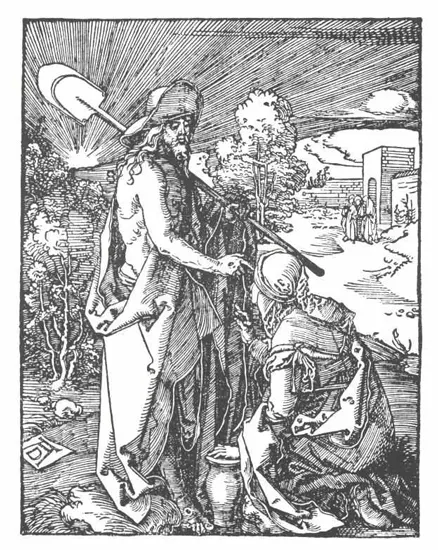It's particularly relevant to Easter Sunday as the phrase is the Latin version of what Jesus Christ is supposed to have said to Mary Magdalene when she saw him after his resurrection (John 20: 14-18) - which is, of course, what Easter Sunday is supposed to be all about.
(This post is to counterbalance the Easter Bunny festival we seem to have these days!)
 |
| Scenes from the Passion of Christ by Hans Memling by Hans Memling oil on panel Galleria Sabauda, Turin click the link to see the entire picture |
- the Greek source - "cease holding on to me" or "stop clinging to me"
- or Latin derivation "don't tread on me" or "don't touch me."
Below are images of the various paintings titled Noli me tangere - in chronological order, with details of who painted them. Paintings are sourced from Wikimedia Commons (link in the title). The location cited in the caption often links to the information page about the painting at the gallery, museum or church where it is now.
I find it fascinating how one single theme - and a phrase - can generate so many different interpretations by different artists over time - especially since the artists are like a roll call of the greats!
Below you can see the development of art by Giotto, Duccio, Fra Angelico, Memling, Botticelli, Dürer, Titian, Holbein, Poussin, Lorrain
Below you can see the development of art by Giotto, Duccio, Fra Angelico, Memling, Botticelli, Dürer, Titian, Holbein, Poussin, Lorrain
 |
| No. 37 Scenes from the Life of Christ: 21. Resurrection (Noli me tangere) (1304-06) by Giotto di Bondone (1266/7 – 1337) Fresco, 200 x 185 cm Cappella Scrovegni (Arena Chapel), Padua |
There are various online images of the Giotto fresco relating to the resurrection (Noli me tangere) because of a recent full-scale restoration of all the frescos in the chapel (hence 'before' and 'after').
This 2015 blog post is worth a read The Scrovegni Chapel: My Moment with Giotto’s Masterpiece
 |
| Noli me tangere (Maestà de Sienne) (c.1308-11) - by Duccio di Buoninsegna (1255-1319) Tempera and gold on wood, 51 x 57 cm Museo dell'Opera Metropolitana del Duomo, Siena |
In this painting, the landscape plays a major part in emphasising the posture of Mary Magdalene.
 |
| Noli me tangere (c.1440-1442) by Fra Angelico (1395-1455) Fresco, Height: 166 cm (65.4 in). Width: 125 cm (49.2 in) San Marco, Florence |
One of the things which struck me while reviewing the painting is what a major part vegetation plays in many of the paintings - and the variations as to whether it was local to the painter or more associated with the Middle East.
 |
| Advent and Triumph of Christ (detail) 1480 by Hans Memling (1433-1494) oil on oak, 31.89 inch wide x 74.41 inch high Alte Pinakothek, Munich, Bavaria, Germany |
However, it's much better represented in the painting (see above) which tells the life and death of Christ - the Advent and Triumph of Christ (see below).
 |
| Advent and Triumph of Christ (1480) by Hans Memling oil on oak, 81.3 × 189.2 cm (32 × 74.5 in) Alte Pinakothek, Munich, Bavaria, Germany |
 |
| Noli me tangere (c. 1484-1491) by Sandro Botticelli (1445 - 1510) Tempera on panel, Height: 197.1 mm (7.76 in). Width: 440.44 mm (17.34 in) Philadelphia Museum of Art |
Predella panel from an altarpiece from the convent of Sant'Elisabetta delle Convertite, Florence, the main panel of which is in the Courtauld Institute Galleries, LondonThe painting was originally painted on one continuous plank of wood, which formed the predella, or base, of an altarpiece.
 |
| Noli me tangere (1511) by Albrecht Dürer (1471-1528) woodcut |
 |
| 'Noli me tangere' (1514) by Titian (1488-1576) oil on canvas, 110.5 x 91.9 cm National Gallery, London |
X-ray photographs show that Christ was originally painted wearing a gardener's hat and turning away from the Magdalen. The landscape was also drastically altered while the work was in progress.
 |
| Noli me tangere (c. 1526-28) by Hans Holbein the Younger (1497-1543) Oil on oak panel, 76.7 x 95.8 cm (support, canvas/panel/str external) Royal Collection, Cumberland Art Gallery, Bedchamber, Hampton Court Palace |
Underdrawing, revealed by infra-red reflectography, and x-radiography show the care with which Holbein planned the work.
 |
| Noli me tangere (1657) by Nicholas Poussin (1594-1665) oil on canvas, 47 x 30cm Museo del Prado |
The Prado link to the painting provides an exceptionally large image.
 |
| Ostermorgan (Easter Morning) Landscape with Christ, who appears to Mary Magdalena ("Noli me tangere") 1681 by Claud Lorrain (1604-1672) Oil on canvas, 84.9 x 141.1 cmStädel Museum |
If you want to explore more of the very many paintings on a theme of Noli me tangere do take a look at this Wikimedia Commons page which has them ordered by centuries
I've rather enjoyed doing this chronological journey through paintings on one theme. I may do it again and not just because of a need tocounteract all those Easter bunnies!
I enjoy with you. Yes, do others chronological subjects, please.
ReplyDeleteThank you very much.
Katherine, thanks for an interesting set of pictures. The tradition of the gardener's hat and shovel alludes to the fact that Mary Magdalene, according to whichever gospel it was, was supposed to have mistaken Christ for a gardener. I have this interesting fact courtesy of Waldemar J and his interesting documentary on Mary Magdalene, http://www.bbc.co.uk/iplayer/episode/b08ljvt7/mary-magdalene-arts-scarlet-woman.
ReplyDeleteThere is also one by Graham Sutherland. It used to hang in Chichester Cathedral but I think it is now in the Pallant Art Gallery.
ReplyDelete